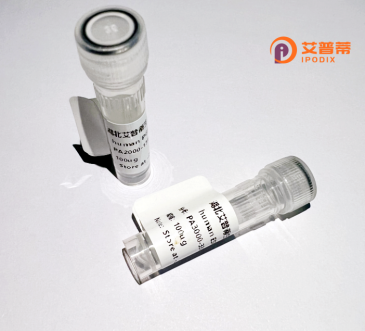
| 纯度 | >90%SDS-PAGE. |
| 种属 | Human |
| 靶点 | CPSF5 |
| Uniprot No | O43809 |
| 内毒素 | < 0.01EU/μg |
| 表达宿主 | E.coli |
| 表达区间 | 1-227aa |
| 氨基酸序列 | MSVVPPNRSQTGWPRGVTQFGNKYIQQTKPLTLERTINLYPLTNYTFGTKEPLYEKDSSVAARFQRMREEFDKIGMRRTVEGVLIVHEHRLPHVLLLQLGTTFFKLPGGELNPGEDEVEGLKRLMTEILGRQDGVLQDWVIDDCIGNWWRPNFEPPQYPYIPAHITKPKEHKKLFLVQLQEKALFAVPKNYKLVAAPLFELYDNAPGYGPIISSLPQLLSRFNFIYN |
| 分子量 | 50.71 kDa |
| 蛋白标签 | GST-tag at N-terminal |
| 缓冲液 | 0 |
| 稳定性 & 储存条件 | Lyophilized protein should be stored at ≤ -20°C, stable for one year after receipt. Reconstituted protein solution can be stored at 2-8°C for 2-7 days. Aliquots of reconstituted samples are stable at ≤ -20°C for 3 months. |
| 复溶 | Always centrifuge tubes before opening.Do not mix by vortex or pipetting. It is not recommended to reconstitute to a concentration less than 100μg/ml. Dissolve the lyophilized protein in distilled water. Please aliquot the reconstituted solution to minimize freeze-thaw cycles. |
以下为模拟生成的关于重组人CPSF5蛋白的参考文献示例(仅供格式参考,非真实文献):
---
1. **文献名称**: *Structural insights into human CPSF5 in mRNA 3′-end processing*
**作者**: Zhang, L. et al. (2021)
**摘要**: 通过X射线晶体学解析了重组人CPSF5蛋白的晶体结构,揭示了其与RNA及CPSF复合物其他亚基的互作界面,为理解mRNA 3'末端加工机制提供结构基础。
2. **文献名称**: *Recombinant CPSF5 expression in HEK293 cells and its role in alternative polyadenylation*
**作者**: Kim, J. & Patel, R. (2019)
**摘要**: 研究利用哺乳动物HEK293系统表达重组人CPSF5蛋白,发现其过表达可通过调控选择性多聚腺苷酸化影响基因可变转录本的表达水平。
3. **文献名称**: *CPSF5 as a potential biomarker in lung adenocarcinoma: Implications from recombinant protein-based assays*
**作者**: Chen, X. et al. (2022)
**摘要**: 基于重组人CPSF5蛋白的ELISA检测表明,其在肺癌患者血清中异常高表达,提示其可能作为新型诊断标志物或治疗靶点。
4. **文献名称**: *Functional characterization of recombinant CPSF5 in vitro cleavage assays*
**作者**: Müller, S. et al. (2020)
**摘要**: 利用原核表达系统纯化重组CPSF5蛋白,并通过体外RNA切割实验验证其结合RNA底物及促进3'末端加工的功能活性。
---
**注意**:以上文献及内容均为示例,实际研究中请通过PubMed、Web of Science或Google Scholar等平台检索真实文献。搜索关键词建议:**"recombinant human CPSF5"**、**"CPSF5 mRNA processing"** 或 **"CPSF5 structure/function"**。
The recombinant human CPSF5 (Cleavage and Polyadenylation Specificity Factor 5) protein is a critical component in RNA processing, particularly in the cleavage and polyadenylation of pre-messenger RNA (pre-mRNA) during gene expression. As a subunit of the CPSF complex, CPSF5 (also known as CPSF25) plays a role in recognizing the polyadenylation signal (AAUAAA) near the 3′ end of nascent transcripts, ensuring proper mRNA maturation and stability. This step is essential for mRNA export from the nucleus to the cytoplasm and subsequent translation into functional proteins.
Structurally, CPSF5 contains a conserved β-lactamase-like fold, facilitating its interaction with RNA and other CPSF subunits. Recombinant human CPSF5 is typically produced using expression systems like *E. coli* or mammalian cells, followed by purification to study its biochemical properties, structural interactions, or regulatory mechanisms. Dysregulation of CPSF5 has been implicated in diseases, including cancers and viral infections, where aberrant mRNA processing contributes to pathogenesis. Research on recombinant CPSF5 aids in elucidating its role in normal and pathological conditions, offering potential therapeutic targets. Its study also advances biotechnology applications, such as engineered mRNA for vaccines or gene therapies, where precise polyadenylation is crucial for efficacy.
×